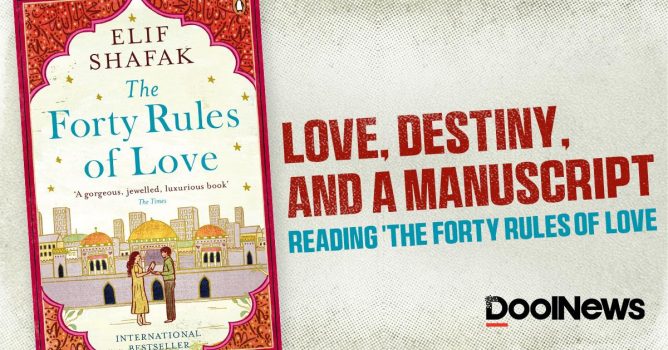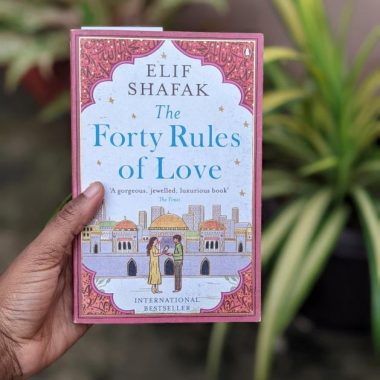
I started reading this book as an attempt to understand love and understand myself. And I guess the book taught me since I fell in love with it at first sight.
This book is ‘The Forty Rules of Love’ by Elif Shafak. On its cover is a remark from The Times: ‘A gorgeous, jeweled, luxurious book.’ When my eyes picked those words up, I thought it referred to the gorgeously designed cover. But reading the first few chapters taught me that it was the writing inside that was jeweled, and that the words were the jewels.
The book reached me on one of the most chaotic days in my life to this day, but reading it left me feeling the most peaceful and tranquil I have ever been in a long time.
This is one of the only books that I actually read the prologue of, and it looped me into the world of that book from the very first sentence. The prologue starts by speaking of what happens when you throw a stone into a river and into a lake.
She describes the sight of a stone falling into a river and a lake so vividly that even I, who had never skipped a stone in my life, nodded in understanding. Though I can’t quite quote the entire two paragraphs of description here, I’ll summarize them and quote what she wrote after.
In still water, the effect of the stone might not be easy to see. It’ll cause a ripple, but that’s all. But in a lake, a circle will form where the stone hits the water, and in a flash that circle will multiply into another, then another. It will expand all over the mirrored surface of the lake and only die out when the circles reach the shore. She writes, “If a stone hits a river, the river will treat it as yet another commotion in its already tumultuous course. Nothing unusual. Nothing unmanageable.
If a stone hits a lake, however, the lake will never be the same again.” Saying this, the author turns to introducing one of the main characters, Ella Rubenstein. Ella lived in Northampton, Massachusetts, with her husband and three teenage children. As the author says, “For forty years Ella Rubenstein’s life had consisted of still waters—a predictable sequence of habits, needs.” That is until a manuscript reaches her.
The book weaves threads of destiny between all four main characters of the book. Her finding of the manuscript seems so vividly like destiny. The meeting of Shams and Rumi is also layered with moments leading up to it in both of their perspectives. It is a book inside a book, a poem inside a poem. And this brocade of love, philosophy, and destiny that Shafak has woven made me feel like finding the book was also destiny, just like it was for Ella. When I was reading the book, I quite quickly forgot that this was written by an author. To me, it felt like it was unfolding that very moment. It felt like Ella was reading the manuscript, right when I was reading the book.
The book is set in 2008 and 13th Century CE at the same time. While the book tells the story of Ella’s journey to love, it also tells the story of the Sufi poet Rumi and Shams of Tabriz. And as much as it is a captivating and addictive novel, it is a philosophical masterpiece. Reading the book is a journey and the start of the greater journey towards love. As Ella reads the manuscript, the reader does too, because the manuscript is inside the book, telling the story of Rumi and Shams from the perspectives of the characters in the story, starting from the Killer of Shams.
For someone who has put off watching shows and reading books simply because I learned they had a sad ending, to learn that the main character dies and still continue on reading the story was something new to me. Even though the story bought me to tears effortlessly and ended in heartbreak, it brought a queer sort of peace upon me.
content highlights: Love, Destiny, and a Manuscript: Reading ‘The Forty Rules of Love